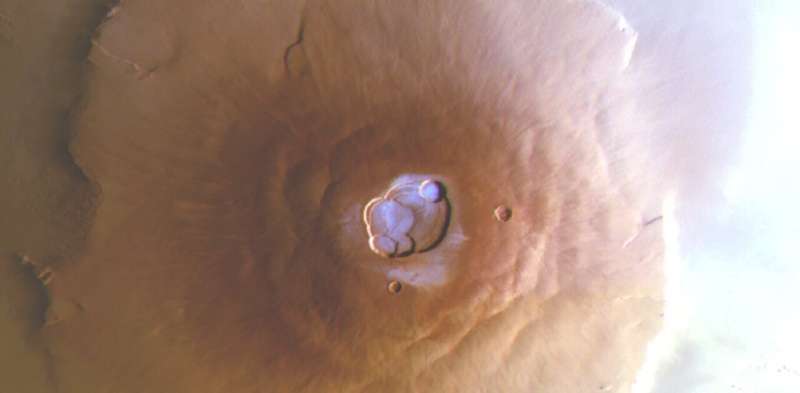The formation of water frost is common on Earth, especially in winter when atmospheric water vapor condenses and freezes on the surface. On Mars, the atmosphere is about 100 times less dense than on Earth, but it too contains water vapor. The atmosphere on Mars contains 10,000 times less water vapor than on our planet, however, so icing is less likely.
The exchange of water between the surface and atmosphere of Mars is currently not well understood. The formation of frost would not only be an important clue for helping us understand the water cycle, but also for identifying key resources for potential future human exploration. Water is a necessary for life and could also be used as rocket fuel.
Journey to the top of Mars’s volcanoes
Our new study, published today in Nature Geoscience, reports the existence of large deposits of transient morning frost at the top of volcanoes in a region of Mars called Tharsis, which includes the volcanoes Olympus, Arsia and Ascraeus Montes, and Ceraunius Tholus. These were detected through analysis of high-resolution color images gathered by the European Space Agency’s Exomars Trace Gas Orbiter (TGO) (ESA) probe. This discovery was confirmed by independent observations made by the ESA’s Mars Express probe and the NOMAD spectrometer onboard the TGO.
Numerical simulations of Mars’s climate show that the surface temperatures of the volcanoes are compatible with the existence of frozen water. In fact, the results show that morning frost deposits are correlated with the coldest Martian seasons (yes, there are seasons on Mars, just as there are on Earth). On Martian peaks, however, the temperatures are much lower, ranging between -130°C and -30°C. What’s more, volcanoes on the planet’s equator are highly exposed to the sun’s energy, explaining the rapid disappearance of frost in the morning.
It all began with the observation of lighter, slightly bluish areas on the summits of Martian volcanoes by the CaSSIS camera. After several months of investigation, these unexpected light areas appear to be present only in the early morning observations and during the cold seasons on Mars. The HRSC camera was able to confirm these observations, but what remained was to find the origin of this phenomenon.

There are two types of volatile compounds on Mars: water (H20) and carbon dioxide (CO2). These two compounds can easily change phase between gas and solid under Martian conditions. Unfortunately, in their solid form, they both appear white or bright in the visible light range (also observable by our eyes) of the CaSSIS instrument. So it’s difficult to distinguish them with a simple image. We therefore had to carry out a real investigation of these slightly blueish areas. We were able to establish two major types of argument, one based on spectroscopy and the other on numerical simulation of the microclimate of Martian volcanoes.
Thanks to the decomposition of the colors or wavelengths of the light coming from the surface, it is possible to distinguish between H2O and CO2. This is the spectroscopy technique, enabled by the NOMAD instrument. We attempted to identify these two compounds on measurements taken in extreme conditions, early in the morning, with little sunlight. As the instrument is optimized to observe the sun directly, these observations are difficult and not easy to read. The results show no CO2 signature and a possible water signature.
However, if CO2 is present over a thin layer, we would not expect to see any spectral signatures. This argument is therefore not definitive. The Belgian members of the team then carried out a numerical simulation of the microclimate of the volcanoes on Mars. This is the same type of tool used to predict the weather on Earth, but here it was adapted to Mars. The simulations conclude that at the time of acquisition of the images containing the clear zones, the conditions were right for the condensation of water, but not of CO2. These two pieces of evidence combined therefore support the hypothesis of water icing .
A thin layer of frost
Using information from the available instruments, we were able to estimate the thickness of this layer of frost. It’s very thin, just 10 micrometers (1/100th of a millimeter). This amount of frost is dictated by the amount of water vapor available in the planet’s atmosphere, just 1/10,000th of that on Earth.
As condensation has to start a few hours before sunrise, atmospheric circulation has allowed water to accumulate from the surrounding atmosphere. Given the surface area covered by the frost, the total quantity of water is on the order of 60 Olympic-sized swimming pools. If it could be harvested, this could cover the water needs of astronauts for several years, but on the scale of the planet Mars, this quantity remains very small. The amount of water available on Mars, mainly in the form of ice in the poles, is estimated at 1 trillion Olympic-sized swimming pools. Bear in mind that there is around 100 times more water on Earth than on Mars.
This discovery of ice on the highest peaks in the solar system will enable us to refine our understanding of the current water cycle on Mars. In this way, it will be possible to better predict the weather on Mars, with a view to future exploration, but also to better understand the past climate of Mars and its potential for habitability.
Provided by
The Conversation
This article is republished from The Conversation under a Creative Commons license. Read the original article.![]()
Citation:
Water frost on Mars: On the top of immense volcanoes, a briefly icy landscape (2024, June 11)
retrieved 11 June 2024
from
This document is subject to copyright. Apart from any fair dealing for the purpose of private study or research, no
part may be reproduced without the written permission. The content is provided for information purposes only.